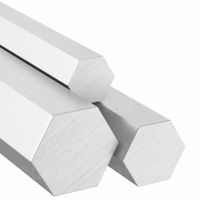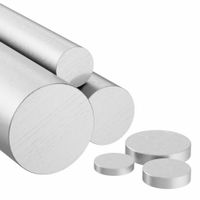Call +(254) 703 030 000 / 751 483 999 / 721 704 777
- Home
- Raw Materials
- Metals
- Aluminum
- Aluminum Bars Rods Discs
.....Read More
Frequently Asked Questions
What are the common grades of aluminum used for bars, rods, and discs?
Common grades of aluminum used for bars, rods, and discs include:
1. **1100**: Known for its excellent corrosion resistance, high thermal and electrical conductivity, and good workability. It is often used in chemical and food processing industries.
2. **2011**: This grade is known for its excellent machinability and is often used for precision machining applications. It is ideal for complex and detailed parts.
3. **2024**: Known for its high strength and fatigue resistance, this grade is commonly used in aerospace applications. It is less corrosion-resistant compared to other grades.
4. **3003**: This is an alloy with good corrosion resistance and moderate strength. It is often used in applications like cooking utensils and chemical equipment.
5. **5052**: Known for its excellent corrosion resistance, particularly in marine environments, and good weldability. It is often used in marine and automotive applications.
6. **6061**: One of the most versatile and widely used aluminum alloys, known for its good mechanical properties, weldability, and corrosion resistance. It is used in construction, automotive, and aerospace industries.
7. **6063**: Often referred to as architectural aluminum, it is known for its excellent finish and is used in applications requiring high-quality surface finishes, such as window frames and irrigation tubing.
8. **7075**: Known for its high strength-to-weight ratio, this grade is used in aerospace and military applications. It is less corrosion-resistant but offers excellent mechanical properties.
9. **5083**: Offers excellent performance in extreme environments, especially in marine applications, due to its high resistance to seawater.
These grades are selected based on specific requirements such as strength, corrosion resistance, machinability, and application environment.
How do I choose the right aluminum grade for my application?
To choose the right aluminum grade for your application, consider the following factors:
1. **Strength Requirements**: Determine the mechanical strength needed. For high-strength applications, consider grades like 7075 or 2024. For moderate strength, 6061 is a versatile choice.
2. **Corrosion Resistance**: If corrosion resistance is crucial, especially in marine or outdoor environments, opt for grades like 5052 or 6061, which offer good resistance.
3. **Machinability**: For applications requiring extensive machining, 6061 is a popular choice due to its excellent machinability. Grades like 2011 and 2024 also offer good machinability.
4. **Weldability**: If welding is necessary, 6061 and 5052 are known for their good weldability. Avoid grades like 2024 and 7075, which are more challenging to weld.
5. **Formability**: For applications requiring bending or forming, consider grades like 3003 or 5052, which offer good formability.
6. **Thermal and Electrical Conductivity**: For applications needing high thermal or electrical conductivity, 1100 or 1350 are suitable choices.
7. **Weight Considerations**: All aluminum grades are lightweight, but if weight is a critical factor, ensure the chosen grade meets the strength-to-weight ratio required.
8. **Cost**: Balance the cost with performance requirements. Common grades like 6061 and 5052 are generally more cost-effective.
9. **Surface Finish**: If aesthetics or surface finish is important, consider how the grade responds to anodizing or other finishing processes. 6063 is often used for applications requiring a good surface finish.
10. **Regulatory and Industry Standards**: Ensure the selected grade complies with any industry-specific standards or regulations.
By evaluating these factors, you can select an aluminum grade that best suits your application's specific needs.
What are the standard sizes available for aluminum bars, rods, and discs?
Aluminum bars, rods, and discs are available in a variety of standard sizes, which can vary based on the manufacturer and regional standards. However, some common sizes are widely recognized in the industry:
1. **Aluminum Bars:**
- **Flat Bars:** Typically range from 1/8 inch to 6 inches in thickness, with widths from 1/2 inch to 12 inches.
- **Square Bars:** Common sizes range from 1/4 inch to 4 inches in width.
- **Rectangular Bars:** Thicknesses range from 1/8 inch to 6 inches, with widths from 1/2 inch to 12 inches.
2. **Aluminum Rods:**
- **Round Rods:** Diameters typically range from 1/8 inch to 12 inches. Lengths can vary, but standard lengths are often 12 feet or 6 meters.
- **Hexagonal Rods:** Common sizes range from 1/4 inch to 2 inches across the flats.
3. **Aluminum Discs:**
- Discs are often custom-cut, but standard diameters can range from 1 inch to 24 inches or more, with thicknesses from 1/8 inch to 1 inch.
These sizes are subject to availability and may vary based on specific alloy types and manufacturing processes. Custom sizes can often be produced to meet specific requirements.
How do aluminum bars, rods, and discs compare to other materials in terms of strength and weight?
Aluminum bars, rods, and discs are known for their excellent strength-to-weight ratio compared to many other materials. Aluminum is significantly lighter than steel, with about one-third of its density, making it an ideal choice for applications where weight reduction is crucial, such as in aerospace, automotive, and construction industries. Despite its lightweight nature, aluminum exhibits good strength, particularly when alloyed with elements like copper, magnesium, or zinc, which enhance its mechanical properties.
In terms of strength, aluminum is not as strong as steel or titanium, but it offers sufficient strength for many applications while providing the advantage of reduced weight. For instance, aluminum alloys like 6061 and 7075 are commonly used in structural applications due to their high strength and good corrosion resistance.
Compared to materials like plastics or composites, aluminum offers superior strength and thermal conductivity, making it suitable for applications requiring durability and heat dissipation. However, composites can sometimes surpass aluminum in specific strength (strength per unit weight) and corrosion resistance, depending on the application.
Aluminum also has excellent corrosion resistance due to the formation of a protective oxide layer, which is an advantage over materials like steel that require additional coatings or treatments to prevent rust. However, in highly corrosive environments, materials like stainless steel or certain composites may offer better performance.
Overall, aluminum bars, rods, and discs provide a balanced combination of strength, weight, and corrosion resistance, making them versatile and widely used in various industries. The choice between aluminum and other materials ultimately depends on the specific requirements of the application, including factors like cost, environmental conditions, and mechanical demands.
What are the typical applications for aluminum bars, rods, and discs?
Aluminum bars, rods, and discs are versatile materials used across various industries due to their lightweight, corrosion resistance, and excellent conductivity.
1. **Construction and Architecture**: Aluminum bars and rods are commonly used in structural applications, such as frameworks, railings, and support beams. Their strength-to-weight ratio makes them ideal for high-rise buildings and bridges.
2. **Transportation**: In the automotive and aerospace industries, aluminum rods and bars are used for manufacturing components like engine parts, wheels, and structural frames. Their lightweight nature contributes to fuel efficiency and performance.
3. **Electrical Industry**: Aluminum's excellent conductivity makes it suitable for electrical applications. Rods and bars are used in power transmission lines, bus bars, and electrical connectors.
4. **Machinery and Equipment**: Aluminum bars and rods are used in the production of machinery parts, such as shafts, gears, and fasteners, due to their machinability and durability.
5. **Consumer Goods**: Aluminum discs are often used in the production of cookware, such as pots and pans, due to their heat conductivity and non-toxic nature. They are also used in manufacturing electronic casings and sports equipment.
6. **Marine Industry**: The corrosion resistance of aluminum makes it ideal for marine applications. Bars and rods are used in boat building, for masts, railings, and other structural components.
7. **Medical Devices**: Aluminum's non-magnetic properties make it suitable for medical equipment and devices, including MRI machines and surgical instruments.
8. **Packaging**: Aluminum discs are used in the production of cans and other packaging materials, providing a lightweight and recyclable option.
These applications highlight aluminum's adaptability and importance in modern manufacturing and design.
How do I properly machine and weld aluminum bars, rods, and discs?
To machine aluminum, use carbide or high-speed steel tools with a positive rake angle to reduce cutting forces. Ensure the tool is sharp to prevent material buildup. Use a high spindle speed and moderate feed rate to avoid chatter. Apply a suitable cutting fluid to improve surface finish and tool life. For turning, use a lathe with a stable setup and ensure the workpiece is securely clamped. For milling, use climb milling to reduce tool wear and improve finish.
For welding aluminum, clean the surface thoroughly to remove oxides and contaminants using a stainless steel brush. Use TIG (Tungsten Inert Gas) or MIG (Metal Inert Gas) welding processes. For TIG welding, use pure argon as a shielding gas and a tungsten electrode. Select the appropriate filler rod, such as 4043 or 5356, based on the aluminum alloy. Maintain a short arc length and use a high-frequency start to stabilize the arc. For MIG welding, use a spool gun or push-pull system to feed the wire smoothly. Set the correct voltage and wire feed speed for the material thickness.
Preheat thicker sections to 300°F (150°C) to reduce thermal stress. Use a back-purge technique for full penetration welds to prevent oxidation. Allow the welded part to cool slowly to avoid cracking. Post-weld, inspect for defects and perform any necessary heat treatment to restore mechanical properties.
Where can I purchase aluminum bars, rods, and discs?
You can purchase aluminum bars, rods, and discs from the following sources:
1. **Online Metal Suppliers**: Websites like OnlineMetals.com, Metal Supermarkets, and McMaster-Carr offer a wide range of aluminum products. They provide detailed specifications and allow you to order custom sizes.
2. **Local Metal Supply Stores**: Check for metal supply stores in your area. These stores often stock various aluminum products and can provide personalized service and advice.
3. **Industrial Suppliers**: Companies like Grainger and MSC Industrial Supply offer aluminum materials for industrial use. They have extensive catalogs and can fulfill bulk orders.
4. **Home Improvement Stores**: Large chains like Home Depot and Lowe's carry aluminum bars and rods, though their selection might be limited compared to specialized suppliers.
5. **Specialty Metal Shops**: Some shops specialize in non-ferrous metals and can offer a wider selection of aluminum products, including custom cuts and sizes.
6. **Online Marketplaces**: Platforms like Amazon and eBay have listings for aluminum bars, rods, and discs from various sellers. Ensure you check the seller's ratings and reviews.
7. **Direct from Manufacturers**: If you need large quantities, consider purchasing directly from manufacturers like Alcoa or Kaiser Aluminum. They can provide bulk pricing and custom orders.
8. **Scrap Yards and Recycling Centers**: For smaller projects or cost savings, check local scrap yards. They often have aluminum materials at reduced prices.
9. **Metal Fabrication Shops**: These shops often have leftover materials from projects and may sell them at a discount.
10. **Trade Shows and Expos**: Attending industry trade shows can connect you with suppliers and manufacturers offering aluminum products.



